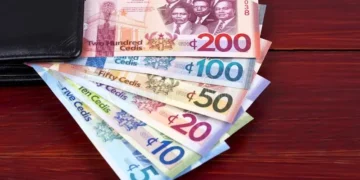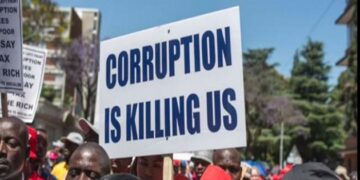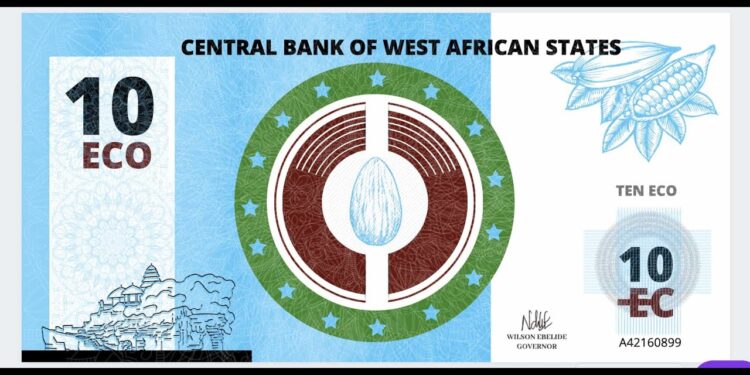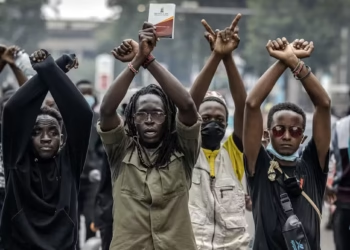The eco, an envisaged common currency for the 15 members of the Economic Community of West African States (ECOWAS), was conceived in 2003 but still hasn’t seen the light of day. The West African Monetary Zone intended the eco to be issued among non-CFA franc member states before the CFA zone of the West Africa Economic and Monetary Union (UEMOA).
The CFA franc is the colonial currency bequeathed to 14 African countries by France. Former French colonies in West Africa use the West African CFA franc while those in Central Africa use the Central African CFA franc. An estimated 150 million Africans used the CFA franc as legal tender.
In December 2019, however, the euro-pegged CFA-franc UEMOA states – Benin, Burkina Faso, Ivory Coast, Mali, Niger, Senegal, and Togo (all former French colonies) together with Guinea-Bissau – wanted it the other way round – to issue the common currency first before the rest of the ECOWAS community adopts it.
This angered the six other non-CFA ECOWAS member states – The Gambia, Ghana, Guinea, Liberia, Nigeria and Sierra Leone, who are under the WAMZ umbrella.
Whatever the case, neither the seven Francophone members plus Guinea-Bissau (Portuguese) nor the six Anglophones have succeeded. It has been postponed four times, at least: 2005, 2014, 2014, and 2020. The eco remains a dream at best; and a mirage, at worst.
The ten convergence criteria set out for the countries by the West African Monetary Institute (WAMI), which would have paved the way for the realisation of the eco, have never been met.
The first four primary criteria are a single-digit inflation rate at the end of each year, a fiscal deficit of no more than 4% of the GDP, a central bank deficit-financing of no more than 10% of the previous year’s tax revenues, and gross external reserves that can give import cover for a minimum of three months.
The six secondary criteria are the prohibition of new domestic default payments and liquidation of existing ones, tax revenue should be equal to or greater than 20 per cent of the GDP, wage bill to tax revenue equal to or less than 35 per cent, public investment to tax revenue equal to or greater than 20 per cent, a stable real exchange rate and a positive real interest rate.
To complicate issues further, three of the UEMOA states: Niger, Mali and Burkina Faso, who used to belong to the 14-member CFA franc zone, have broken ties with ECOWAS and are now pursuing a new common currency of their own – the Sahel.
Benin, Burkina Faso, Côte d’Ivoire, Guinea-Bissau, Mali, Niger, Senegal and Togo make up the West African Economic and Monetary Union (WAEMU), whose central bank is the Central Bank of West African States, BCEAO. The others are Cameroon, Central Africa, Congo, Gabon, Equatorial Guinea, and Chad, which form the Economic and Monetary Community of Central African States (CEMAC), whose central bank is the Bank of Central African States (BEAC).
The CFA franc was created on December 26, 1945, the date on which France ratified the Bretton Woods Agreements and made its first declaration of parity to the International Monetary Fund (IMF). At the time, the name meant “franc of the French Colonies of Africa”. It was later known as the “franc of the African Financial Community” to the member States of the West African Monetary Union (WAMU) and as the “franc of Financial Cooperation in Central Africa” to the member countries of the Central African Monetary Union (CAMU).
As far as convertibility goes, it is guaranteed in French francs by the French Treasury. It has total freedom of transfer within the Franc Zone and can take the place of foreign currencies through the exchange markets of Paris, with the French franc as its anchor. The CFA franc was initially pegged to the French franc and has been linked to the euro for about two decades.
At the time of the announcement to go Eco, Ivory Coast President Alassane Ouattara said three “three major changes” were necessary for that to happen. One was a change of name of the currency. The other changes, he mentioned, would be “stopping holding 50 per cent of the reserves in the French Treasury” and the “withdrawal of French governance” in any aspect related to the currency. French President Emmanuel Macron hailed it as a “historic reform”, adding: “The Eco will see the light of day in 2020.”
However, it appears 2020 has been forever coming. The CFA franc’s value was moored to the euro after its introduction two decades ago, at a fixed rate of 655.96 CFA francs to one euro. The Bank of France holds half of the currency’s total reserves, but France does not make money on its deposits stewardship, annually paying a ceiling interest rate of 0.75 per cent to member states. The arrangement guarantees unlimited convertibility of CFA francs into euros and facilitates inter-zone transfers. CFA notes and coins are printed and minted at a Bank of France facility in the southern town of Chamalieres.
The Eco has been a long-dreamt-of and, sometimes, an almost dead dream of the ECOWAS bloc of 385 million people, formed in 1975 and comprising Benin, Burkina Faso, Cape Verde, The Gambia, Ghana, Guinea, Guinea-Bissau, Ivory Coast, Liberia, Mali, Niger, Nigeria, Senegal, Sierra Leone and Togo.
The proposed ‘Sahel’ by the juntas of Burkina Faso, Mali and Niger, has raised hopes, once again, among anti-Franceafrique advocates, of an eventual severing of ties between these African nations and their former colonial master, France, who still looms large over their economic and political fortunes. One ‘Sahel’ is envisaged to be equal to 1,000 CFA francs. The ‘Sahel’ is seen as a symbol of resistance against The Establishment – France – and a declaration of absolute independence from a former colonial master, who is still intricately involved in the economic and political life of Francophone West African countries, who, more or less, have been the master’s puppets.
A total breakaway from the CFA franc would be a major milestone toward total independence for these Francophone West African countries whose economies have suffered decades of strangulation by the French government. And it appears the current military leaders of the triad are wasting no time at all toward achieving that goal. The desire for total independence of France by this triad may even have been the main reason that bolstered their putsches in their separate countries within short intervals of each other.
The 14 former French colonies in Africa still pay a “colonial tax” amounting to about $500 billion annually, according to an article by Sikhumbuzo Thomo, an activist, published by the Mail & Guardian website on 20 August 2023. These 14 countries have a combined population of 174 million and a nominal total GDP of $196 billion, with a purchasing power parity GDP of $411 billion, the article, titled, “Former French colonies are still paying a ‘colonial’ tax”, said.
This economic neo-colonisation of these African states requires that a portion of their budget continues to flow to the French central bank, which gives France the chance to appropriate about 85% of the former colonies’ annual income. “As a result, African countries face financial difficulties and have to borrow back their own money from the French central bank as debts. To reclaim their funds, African countries are limited to applying for no more than 20% of the transferred amount. If they seek a larger sum, it can be vetoed. France argues that it is the money it spent on buildings and infrastructure constructed more than a century ago. Any refusal by an African ruler to pay the colonial tax often leads to a coup”, the article said.
For instance, Sylvanus Olympio, the first president of Togo, rejected France’s colonisation continuation pact but agreed to pay a hefty annual debt to avert destruction. Struggling financially, he aimed to break from the French colonial currency in 1963, opting for Togo’s own currency. Three days into this move, he was assassinated by soldiers allegedly backed by France. Similarly, Modiba Keita of Mali faced a coup in 1968 after withdrawing from the French colonial currency. Notably, ex-French Foreign Legionnaires played pivotal roles in several coups across African nations seeking independence. Over the past 50 years, 67 coups occurred in Africa, with 61% in French ex-colonies.
Two French presidents, in the past, highlighted the crucial dependence of France on Africa. Francois Mitterrand, in 1957 said: “Without Africa, France will have no history in the 21st century”. Decades later, President Jacques Chirac, in March 2008, said: “Without Africa, France will slide down into the rank of a third [world] power”. These demonstrate how much oxygen the 14 former colonies are to France’s economic and, by extension, political stature in the global scheme of things.
More recently, Ms Giorgia Meloni, a right-wing politician who has become Italy’s new prime minister, accused France of using a “colonial currency” to “exploit the resources” of African countries. A video of her comments went viral on social media. The video is from an interview she gave on 19 January 2019 on the private Italian TV channel La 7, when she was an MP and leader of the right-wing party, Brothers of Italy. On the video, she held up a CFA franc bank note, and furiously described it as a “colonial currency” that France prints for 14 African countries which, she said, it uses to “exploit the resources of these nations”. She then held up a picture of a child working in a gold mine in Burkina Faso and asserted that “50% of everything that Burkina Faso exports ends up in… the French treasury”. “The gold that this child goes down a tunnel to extract mostly ends up in the coffers of the French state”, Ms Meloni added.
The video clip ends with her saying, “The solution is not to take Africans and bring them to Europe, the solution is to free Africa from certain Europeans who exploit it”. She was commenting on African immigrants trooping to Europe for greener pastures with many of them ending up dead on the perilous journey.
Economic Implications Of The CFA franc
According to a publication on Tax Justice Network by Dr Ndongo Samba Sylla titled, ‘The CFA Franc as a vivid symbol of colonial continuities in Francophone Africa’, “The purpose of this ‘monetary arrangement’ from its origin to the present day is to maintain satellite economies that are ‘complementary’ to the French economy. That is, economies that serve as cheap sources of raw material supplies and captive outlets”.
Dr Sylla, a Senegalese development economist and researcher at the West Africa Office of the Rosa Luxemburg Foundation and co-author with Fanny Pigeaud of ‘Africa’s Last Colonial Currency: The CFA Franc Story’, paints a gloomy picture of the economic implications of holding onto the CFA franc, by the 14 former French colonies.
Quoting Dr Sylla extensively, he explained: “The fixed parity reduces transaction costs and protects French companies (and now all foreign companies operating in euros) from exchange rate risk. The structural overvaluation of the CFA franc, the artificially high level of its value against the reference currencies, tends to favour imports, including luxury goods, to the detriment of exports”.
“The fixed parity thus constitutes a kind of trade preference granted to the eurozone, since African countries cannot use their exchange rate as an instrument to boost at times the price competitiveness of their exports. Finally, it deprives the Central Bank of West African States and the Bank of Central African States of the possibility of using the exchange rate to absorb shocks. Thus, in the event of a crisis, the need to defend the peg implies a reduction in public expenditure and credits to the economy, as well as an increased dependence on external financing flows”, he continues.
Also, he noted: “As for the freedom of transfer, it allows for the free investment and disinvestment of French capital as well as the repatriation of profits, dividends, etc. In resource-rich CFA countries, this freedom is often associated with significant financial bleeding. For example, over the period 1970-2008, illicit financial flows from Côte d’Ivoire and Cameroon are respectively estimated in 2008 US dollars at 66.2 billion and 33 billion, which was 6 times and 13 times higher than their respective stock of external debt”.
“In addition to the handicaps resulting from an overvalued exchange rate and the outward transfer of local economic surpluses, the behaviour of the banking sector retains its colonial character”, he indicated.
Dr Sylla indicated: “In CFA countries, credits to the economy remain low, with short maturities and prohibitive interest rates. Loans are mainly oriented towards the trade sector to the detriment of investment in agriculture and manufacturing. Bank loans are primarily targeted at large companies and governments to the detriment of SMEs in general. The decline in the market share of French banks in CFA countries has not changed this general observation. The banking landscape has become less oligopolistic but is still largely dominated by foreign banking groups. In Senegal, for example, the latter control more than 90 per cent of banking assets”.
“Thus, domestic production in CFA countries is penalised on the one hand by the low level and inadequacy of the credits to the economy and on the other by the overvaluation of the exchange rate. This pattern is aggravated by trade liberalisation policies and those dictated by the ideology of fiscal austerity”, he mentioned.
He continued: “The persistence of neo-colonial monetary and financial relationships has favoured neither structural transformation nor regional integration, and has done even less for the economic development of the CFA countries, 9 out of 14 of which are among the Least Developed Countries. In terms of health and education achievements, CFA franc-using countries occupy the lowest ranks worldwide. Among a total of 189 countries, Niger, Central African Republic and Chad had the lowest score on the 2020 Human Development Index. Looking from a long-term perspective, average real incomes have stagnated or declined in five of the biggest CFA franc-using economies: Cote d’Ivoire, Cameroun, Gabon, Senegal and Congo Republic”.
“If this monetary bond did not prevent the commercial and financial decline of France in its sphere of influence, it has nonetheless contributed to the institution of centralised political regimes that are more responsive to the priorities of the French government, French companies and foreign investors than to the interests of their citizens. For example, in oil-exporting CFA countries such as Chad, Gabon, the Republic of Congo and Equatorial Guinea, the ‘president for life’ model remains the norm, notwithstanding the frequent organisation of formal elections with a foregone conclusion.”
“In other words, the CFA franc existence favours a particular type of political leadership. Those who can aspire to lead CFA countries are those who will not question its limitations. It is these leaders that have enjoyed the active solidarity and support of the French government over the last six decades”, he observes.
Security Implications Of The Continued Use Of The CFA franc
There are bound to be more coups in former French colonies in Africa if the CFA franc persists since France, to keep its interest in the prevailing monetary imperialism, is more likely to form local alliances with opposition elements and coup-mongers against anti-CFA franc political leaders. It happened to Togo’s Olympio and Mali’s Modiba Keita in the past.
Guinea’s Sekou Touré also had his share of French fury when he refused to play ball in 1958 by opting for independence from the French colonial empire. Paris’s enraged colonial elite executed a vindictive campaign against his government. Three thousand French citizens left, destroying schools, nurseries, and public buildings. They crushed cars, books, and medical supplies; and sabotaged research instruments. Livestock was killed, and food in warehouses burned or poisoned. This extreme act aimed to deter other colonies from seeking independence. The chilling message left a lasting impact, instilling fear in the African elite, and preventing further attempts to break free. Sékou Touré’s defiant slogan, “We prefer freedom in poverty to opulence in slavery,” echoed in the aftermath.
Like in the past, French-conspired coups could sweep through the sub-region, thus, creating political and economic instability which could spiral into food insecurity, famine, humanitarian crises, and death and even provide a fertile hub for terrorist activities.
Such disturbances could also infect and affect rather peaceful havens and oases of tranquillity in the turbulent region.
Coup-mongers could take inspiration from such putsches, to overthrow their governments just to perpetuate themselves in office and enjoy the trappings thereof with reckless abandon amidst unbridled corruption and obscene opulence, which, in itself, as happened in the French Revolution, trigger a series of civil uprising on the continent, thereby, locking Africa in an unending cycle of war, destruction, hopelessness, despair and macabre images in the Western media.
Economic Benefits Of A Common Currency
Should the ‘Sahel’ or ‘eco’ come into being, either would join the ranks of other single-currency zones like the Eurozone, of which nine of its 12 members use the Euro, which came into being in 1999. The UK, Denmark and Greece are the only EU members that did not join the single-currency zone. A common currency eliminates the cost of conversion from one currency to another. It also increases price transparency since prices in different currencies can be difficult to compare. If everything is in the same currency, price comparison is straightforward. This helps to cut costs, as less effort and time go into finding the cheapest product more easily. A common currency also increases competition and efficiency since there is greater transparency in prices. Additionally, a single currency increases inward investment. The single market in Europe, for example, has more than 200 million consumers and after enlargement in 2004, has more than 300 million. With the Euro being one of the most significant world currencies, the possibility of increased inward investment from the rest of the world is increased. This could be the lot of the Sahel region if the Sahel comes to fruition and eventually becomes a currency of international trade that wields some economic significance. Having a single currency also eliminates exchange rate uncertainties and, thus, encourages intra-zone trading. Conversely, though, there are economic arguments against single-currency zones. For starters, a single currency requires a single monetary policy. This means interest rates are set centrally for all countries belonging to the zone. In this case, a central bank common to the zone would have the final say on interest rates for the Sahel region. For instance, if Burkina Faso is suffering a downturn in economic activity, but Niger and Mali are booming, the central bank may hike interest rates, but that would simply worsen the recession for Burkina Faso. The same consequence is likely to be true for the eco, if it comes to fruition. Another demerit is the possibility of the same policy having different effects on different countries. Also, external economic shocks may have an adverse impact. Apart from these, switching over to the new single currency is very costly since the new currency has to be issued while the different old ones of each country belonging to the zone, are steadily phased out. Additionally, ATMs, vending and point-of-sale machines have to be adapted to take the new coins, and foreign exchange departments may shrink in size in some financial institutions.






























